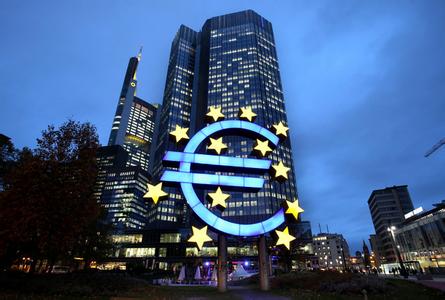Might the policies of the eurozone result in a robustrecovery? My answer is: no. Since the eurozonegenerated 17 per cent of world output in 2013 (atmarket prices), that answer has global significance.
欧元区的政策会不会促成强劲复苏?我认为答案是否定的。鉴于2013年欧元区产出占世界总产出的17%(以市场价计算),这个否定答案对全世界都有意义。

It is Germany that set the economic strategy of the eurozone. It consists of three elements:structural reform; fiscal discipline; and monetary accommodation. So far, this set ofpolicies has failed to generate adequate demand: in the second quarter of 2014, real demandin the eurozone was 5 per cent smaller than it was in the first quarter of 2008.
制定欧元区经济策略的是德国。这一策略包含三个部分:结构改革、财政纪律、宽松货币政策。迄今为止,这一套政策一直未能创造足够的需求:2014年第二季度,欧元区实际需求比2008年第一季度少5%。
Both France and Italy are being encouraged to accelerate “structural reforms” as a way toreignite growth in their own economies and so, given their importance, also in the eurozone.These two countries generate 38 per cent of eurozone gross domestic product, against 28 percent for Germany alone. In both economies, the recommended programmes involveliberalising the labour market. They are both being encouraged to follow Germany’s “Hartzreforms”, introduced between 2003 and 2005, to which the country’s relatively good recentlabour market performance is often attributed.
法国和意大利都受到鼓励要加快“结构改革”,以重启本国经济增长,鉴于这两国的重要性,这也就相当于重启欧元区经济增长。这两个国家的国内生产总值(GDP)之和占欧元区的38%,而德国一个国家占28%。在法意两国,被鼓励实施的改革计划都包括放开劳动力市场。法意两国都被鼓励效仿德国在2003年至2005年之间推出的“哈尔茨改革”(Hartz reforms),人们往往将德国近期相对不错的劳动力市场表现归功于该项改革。
Yet the one thing those reforms did not do is create dynamic aggregate demand. Betweenthe second quarter of 2004 and the second quarter of 2014, Germany’s real domestic demandgrew 11.2 per cent, a compound annual rate of 1 per cent. It could have been worse. But thisis hardly the performance of a “locomotive” (see chart).
然而,哈尔茨改革没有实现的一点是创造活跃的总需求。从2004年第二季度到2014年第二季度,德国实际内需增长了11.2%,相当于1%的复合年化增长率。情况原本还可能更糟。这很难算是“经济火车头”应有的表现。
本文关键字: 欧元区值得为扩张政策冒险
 免费试听
免费试听

时长 : 29:45 主讲 : 乔迪

时长 : 44:09 主讲 : 徐宸

时长 : 21:15 主讲 : 徐宸

时长 : 21:15 主讲 : 徐宸

时长 : 44:09 主讲 : 徐宸

时长 : 29:45 主讲 : 乔迪

时长 : 15:31 主讲 : 徐新磊

时长 : 18:37 主讲 : 孔令金

时长 : 15:31 主讲 : 徐新磊
 推荐阅读
推荐阅读
第十三届全国人民代表大会第二次会议(the second session of the 13th National People& 39;s Congress)5日上午在人民大会堂开
第十三届全国人民代表大会第二次会议(the second session of the 13th National People& 39;s Congress)5日上午在人民大会堂开
第十三届全国人民代表大会第二次会议(the second session of the 13th National People& 39;s Congress)5日上午在人民大会堂开
第十三届全国人民代表大会第二次会议(the second session of the 13th National People& 39;s Congress)5日上午在人民大会堂开
第十三届全国人民代表大会第二次会议(the second session of the 13th National People& 39;s Congress)5日上午在人民大会堂开
第十三届全国人民代表大会第二次会议(the second session of the 13th National People& 39;s Congress)5日上午在人民大会堂开
第十三届全国人民代表大会第二次会议(the second session of the 13th National People& 39;s Congress)5日上午在人民大会堂开
第十三届全国人民代表大会第二次会议(the second session of the 13th National People& 39;s Congress)5日上午在人民大会堂开
第十三届全国人民代表大会第二次会议(the second session of the 13th National People& 39;s Congress)5日上午在人民大会堂开
第十三届全国人民代表大会第二次会议(the second session of the 13th National People& 39;s Congress)5日上午在人民大会堂开
